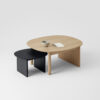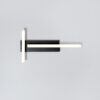Donald Judd (1928 – 1994) was one of the most influential artists of the 20th century. He is considered one of the pioneers of the Minimalist Art movement in America. His artistic work includes sculptures, paintings, drawings, and furniture.
After serving in the United States Army, he studied philosophy and art history at Columbia University and painting at the Art Students League. He eventually began his career as an art critic and painter. Constrained by the notion of having to hang his paintings on a wall, he incorporated more and more three-dimensional objects into his works in the early 1960s. He was fascinated by how a created object interacted with space and thus changed it. He was committed to the idea of creating art not only as a visual experience but also as an experience through space. In the early 1970s, he also began designing furniture.
His carefully arranged groups of objects gave the space an entirely new structure and opened up hidden interstices through the interaction between architecture and the viewer. Thus, he created interactions between open and closed volumes, interior and exterior forms, and transparent and compact surfaces.1
Actual space is intrinsically more powerful and specific than paint on a flat surface.
Donald Judd
His works were characterized by a sober design and the use of industrial materials such as steel and Plexiglas. His minimalist objects were a rejection of the Abstract Expressionism of the time and influenced many other artists.
Donald Judd was an inspiring artist and person. His work was always intentionless, as he once revealed in an interview with art historian Barbara Rose in 1967. “It’s just intended to get done, that’s all.” He didn’t like being pigeonholed. He strictly rejected the term “Minimalism” – as well as the word “sculpture” for his objects. His works could not be categorized either. Judd always held to the conviction that artists do not have to try to explain themselves. He believed that good art should speak for itself.
Judd captured his thoughts in several essays on art, architecture, and design. His books, which dealt with topics such as minimalism, space, and structure, were groundbreaking for the art world.
In 1994, Donald Judd died in New York. His legacy as one of the most influential artists of the 20th century still lives on today. Judd refused to accept the more conventional approaches to art, criticizing the idea that it must always be an active act of interpretation. Instead, he emphasized direct experience as an important component of viewing art. He used simple materials and geometric forms and promoted a new understanding of spatial continuity and aesthetic perception of art.


